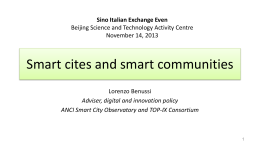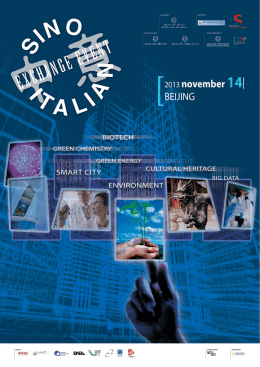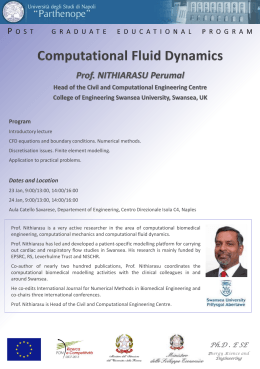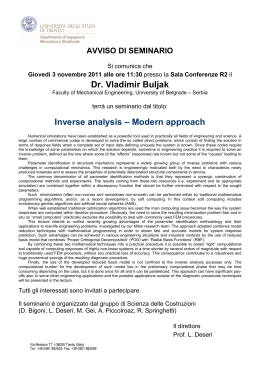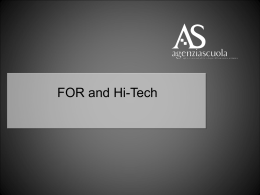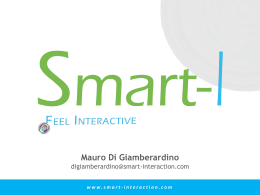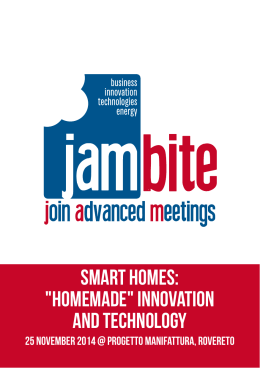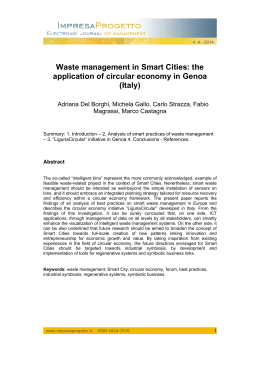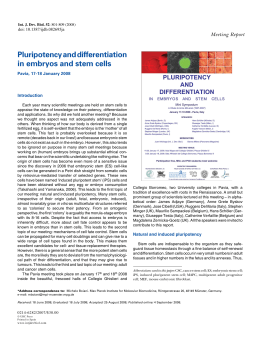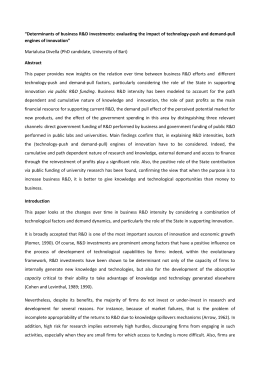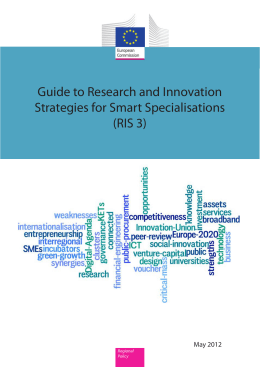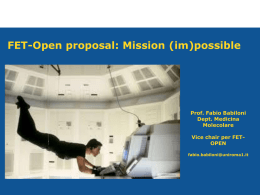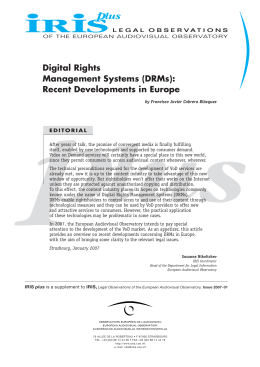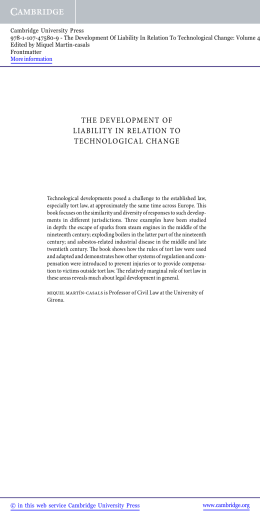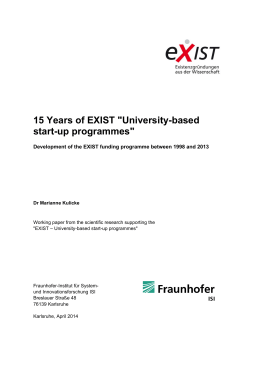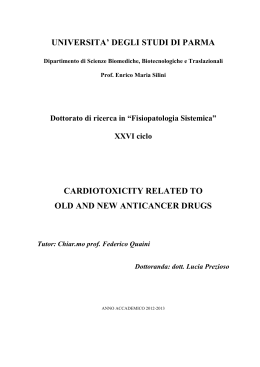Smart Cities, Citizenship Skills and the Digital Agenda: The Grand Challenges of Preparing the Citizens of the Future Theo Tryfonas, University of Bristol and Tom Crick, Cardiff Metropolitan University Introduction – the current context Our cities and communities are places where aggressive urbanisation, steep population increase and climate change pose substantial challenges, if not an existential threat. Therefore the use of technology as a facilitator for adaptation, resilience and sustainable development is vital. Many aspects of urban life are already experiencing a major transformation as cities capitalise upon technological capabilities to improve efficiency and control of operations and ultimately redefine the citizen’s experience. Ideas that were once deemed within the sphere of wild science fiction fantasy are being brought within reach by recent developments in mobile computing, civic technologies, wearables and other technological innovations: self-driven electric cars, parcel delivery drones and robotic assistants to name but a few. However, technology should not develop in isolation of the needs and challenges of our society; it is essential to put these in context. History shows how the potential of great innovations may be left untapped. For example early versions of steam-powered engines, such as Heron’s engine 1, were invented as early as 100 AD but their potential was only fully realised much later during the Industrial Revolution. In turn, these emerging technologies could reshape many aspects of modern life at great pace that may require significant readjustment by society, if adopted. We argue later that, besides contextualising technological innovation, a delicate balance between innovation pace and adjustment to change can only be achieved when society possesses the right skills to cope with and capitalise on these. In the UK there is a significant strategic focus on the investment, planning and development of physical infrastructure for achieving prosperous cities and regions and coping with these challenges. In addition, the recent debate for more devolved powers for cities and regions has become a driver for novel development models with many regions preparing to capitalise on any proposed reforms2. However critical digital infrastructure and its interaction with the physical environment is frequently retrofitted, and even overlooked and commoditised: data, connectivity and smart systems. However, to successfully enable the technological promises to become a reality when planning for the future of our cities, we need to view the requirements of both the ‘hard’ physical, utilities and digital infrastructure, and the ‘soft’ architecture and delivery processes as interrelated parts of the wider planning problem. It is such an integrated view that will enable these solutions to be fully contextualised. Some models driving growth in this area are already in existence. For example InnovateUK is a source of substantial support for future cities technology, with funding programmes orientated towards smart infrastructure, sustainable buildings, data-driven entrepreneurship, sensors, and the Internet of Things amongst others. In addition, the various thematic Catapult centres form a platform that provides the essential networking, seeding and incubation of ideas to drive forward developments in Future Cities, Digital, Transport, etc. Many city authorities themselves have contributed by enabling and fostering innovation through incubation models, such as e.g. the Engine Shed in Bristol 3. Many of these organisations, plus a number of growing incubators like FabLabs 4 facilitate events that aim at bringing the right people together under conditions that foster creative innovation (‘hackathons’). All of these means are examples of a rich network of opportunity for the development of future cities technology. However, there exists an underlying presumption is that these forms of support and incubation are available and accessible to citizens, who in turn have the requisite skills and capabilities to make their ideas come to life. Entrepreneurship, design, technology awareness, computational thinking and programming skills amongst others, are all part of the potentially useful mix of abilities to develop urban technologies supported by these platforms. If these means are to become key forms of civic technology production platforms, any assumption about the skills and abilities of the citizen towards whom they are intended ought to start taking centre stage in the debate. Is there really a skills gap for the future? So what would conceivably be the digital citizenship skillset in a smart city? Are our current educational and skills development processes orientated towards the challenges that future cities and their inhabitants are anticipated to face? Entrepreneurship and creativity, design and making, and computational and systems thinking are skills very much required. After all, engineering technologies are developed by people for people. Alarmingly, several organisations and institutions have independently signalled issues in the pipeline of certain skillsets that would be deemed highly relevant in the future cities context and their labour markets 5,6. Different cycles of economists7 debate whether there is a shortage of such skills (particularly related to science, technology, engineering and maths – STEM). However there is certainly an imperative for nations to deliver such skillsets through their educational systems more aggressively 8. There has also been significant attention at the European level, particularly with the development of digital competences through the Digital Agenda for Europe and evidence brought forward of its impact on many vital sectors such as future care services 9. Across the UK a high-profile debate on reform of the traditional ICT curriculum has culminated in changes (in England from September 2014 10, with significant reform expected in Wales) that emphasises more the scientific and conceptual aspects of computing, rather than transient skills and applications of information technology11. Despite this emphasis, the UK and Europe are still perceived to be behind global competitors such as the US, Canada and China. For example a conscious initiative to address future citizenship challenges has been developed in the US, where currently 19 states contribute to the ‘Partnership for 21st Century Learning’ 12. Their framework addresses leadership, innovation, technology and key skills (e.g. finding information, presenting, critical thinking etc.) that are deemed essential in this context. But education is not just about skills development – and skills should not only be viewed in the context of a job market. The Speaker’s Commission on Digital Democracy 13 report highlighted a number of key areas where future citizens should be concerned. These include increased participation in political processes (e.g. engagement with elected representatives, e-petitions, social media debates) and the ability to understand and use electronic means of voting. Furthermore the ability of social media to foster community relationships and nurture grass roots movements has already become a key medium for enabling political process and engagement with the public, with high profile examples coming from US politics14. One of the implications here is that, not only may citizens be disadvantaged with respect to future job skills, but also in terms of participation to community life and political process, where they may have limited or no access to emerging technologies that become mainstream. Grand challenges Can we actually plan for and deliver these digital citizenship skills we discuss here? Many would argue that universities cover aspects of entrepreneurship, design, innovation, teamwork etc., through their current offered undergraduate and postgraduate curricula. A recent industrial report highlighted several educational Smart City initiatives across the UK 15, including the course taught by one of the authors of this piece (p. 72) 16. However, the typical university offering is still rooted deeply in 19th century disciplinary divides and silos to deliver skills in sub-divisions of ‘science’, ‘engineering’, ‘arts’, etc. 17. The traditional curriculum model served well the science and technology sectors of the 20th century and contributed to the almost unimaginable boom of technology development. However, even then pioneers like Alan Turing, John von Neumann and Lilian Gilbreth were multi-disciplinarians who worked across the interfaces of science, engineering and art. We are now also seeing the powerful interdisciplinarity in science and engineering research, where computational techniques are shaping not just how science is done, but what science is done 18. However, access to university education is not universal. Traditional academic study is not suited to everyone and socio-economic barriers to university still exist in many developed nations. Therefore, the university curriculum alone should not be the focal instrument of delivering these skills. On the other hand, the university as a whole, with its public engagement and widening access initiatives, can be part of the solution, along with new hybrid models of delivery and participation such as massive on-line open courses (MOOCs). In the UK it is understood that the Open University is preparing a smart city course along these lines, to be offered publicly from October 2015. But yet again the success of this model presupposes resolution of concerns with respect to the digital divide, digital competencies and access to equipment. These matters are essential to be dealt with through effective policy interventions, because for citizens to engage fully with future forms of political process, trust is an essential aspect. This can only be built upon a sound understanding of the nature of the technology, involvement with broad actions of public engagement and, where possible, more specific engagement with open innovation platforms. An example of the latter is Bristol Is Open’s Programmable City initiative 19. There is a need for technology to be viewed as an enabler, as opposed to be demonised and fundamentally mistrusted – which is one of the side-effects of the ever challenging surveillance versus privacy debate, especially in the light of recent whistleblowing about government surveillance programmes. Greater transparency of these programmes and sufficient oversight structures would assure the public of the role of technology, without harming the potential for capitalising on innovation and change that is based on intimate and potentially intrusive technology – mobile phones, wearable devices, wireless sensors and similar. Unfortunately, there are many other socio-cultural barriers that could prohibit the proliferation of these skills. Ethnic minority and female access to STEM careers is a concern 20 as it limits the pool of talent with respect to the technological dimensions of future cities. Many initiatives are underway across sectors to address these issues, but certainly more could be done. And in addition, a potential move towards a more free market approach in Higher Education may lead to a greater squeeze of funding for the humanities in the UK, but also globally21 given current rates of support. This could deprive the field of fundamental thinking, as it is hard to imagine a debate on future cities for example that is not shaped around the imagery of Fritz Lang’s iconic Metropolis, or the dystopian urban landscapes of Blade Runner! Conclusion Thankfully we have seen important steps in resolving some of these issues. Reform of the school curriculum, from developing baseline digital competencies to deeper computing, computational thinking and programming skills, is crucial in changing wider public perceptions of technology and its impact on our lives, as well as equipping young people to live and work in a more computational world. Shifting society towards digital creation rather than just consumption could catalyse a profound change in civic engagement. Developing a digitally confident and capable citizenry through long-term technology innovation strategy and industrial policy could be achieved all the way from using open data as an effective policy instrument through to digital infrastructure being viewed as the critical fifth utility. Where successes have been achieved is because the technology, society and policy interfaces have worked in harmony prioritising needs, enabling integration by breaking barriers of existing silos and delivering purposeful technology. In the light of challenges faced by our cities this is even more critical to happen now. This is a triple-axis issue. First, ICTs are essential platforms that can no longer be viewed as an add-on. For example, it is inconceivable that a city planner would not consider how a building will be linked to power and water supplies in the present day. In the near future, it should be just as inconceivable that a city planner would not consider how a building will be physically and logically connected to the ‘cyberspace’. Equally for technology developers not to consider the nature of needs of the citizen, and where process and policy is required to enable (or regulate) their artefacts, would be detrimental. Finally, for the citizen to pass on the opportunity to engage with enabling and life-changing technology is an opportunity that, given the challenges our cities and communities face, we cannot afford to miss as a society. 1 Steam Engine, Alexandria 100 CE, www.smith.edu/hsc/museum/ancient_inventions/steamengine2.html 2 What is the Northern Powerhouse?, www.bbc.co.uk/news/magazine-32720462 3 Bristol Engine Shed, www.engine-shed.co.uk/ 4 FabLabs UK, www.fablabsuk.co.uk/ 5 UK House of Lords Digital Skills report, www.publications.parliament.uk/pa/ld201415/ldselect/lddigital/111/111.pdf 6 UK Digital Skills Taskforce report, www.ukdigitalskills.com/wpcontent/uploads/2014/07/Binder-9-reduced.pdf 7 The STEM shortage paradox, http://live.iop-pp01.agh.sleek.net/2014/09/25/the-stemshortage-paradox/ 8 The global race for STEM skills, www.obhe.ac.uk/newsletters/borderless_report_january_2013/global_race_for_stem_skills 9 How digital competence development brings better care services: the CARERPlus project, http://ec.europa.eu/digital-agenda/en/news/how-digital-competence-development-bringsbetter-care-services-carerplus-project 10 National computing curriculum (England), www.gov.uk/government/publications/national-curriculum-in-england-computingprogrammes-of-study 11 Coding at school: A parent’s guide to England’s new computing curriculum, www.theguardian.com/technology/2014/sep/04/coding-school-computing-childrenprogramming 12 Partnership for 21st century learning, www.p21.org/ 13 Speaker’s Commission on Digital Democracy, www.parliament.uk/business/commons/the-speaker/speakers-commission-on-digitaldemocracy/ 14 Obama’s Social Media Team Tries to Widen Audience for State of the Union Address, www.nytimes.com/2015/01/20/us/politics/doing-more-than-putting-an-annual-addressinto-140-characters.html 15 Delivering the Smart City, www.arup.com/smart 16 Smart cities course, Univ. of Bristol, http://bit.ly/1cIHiaj 17 U-Lab: Prototyping the 21st-Century University, www.huffingtonpost.com/ottoscharmer/u-lab-reinventing-the-21s_b_5669425.html 18 Science as an open enterprise, https://royalsociety.org/policy/projects/science-publicenterprise/Report/ 19 Bristol Is Open, www.bristolisopen.com/ 20 Diversity in STEM: What It Is and Why It Matters, http://blogs.scientificamerican.com/voices/diversity-in-stem-what-it-is-and-why-it-matters/ 21 Trends in Arts & Humanities Funding 2004-2012, www.researchtrends.com/issue-32march-2013/trends-in-arts-humanities-funding-2004-2012/
Scarica
